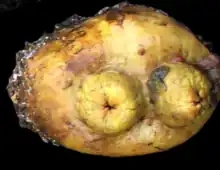Pyura dalbyi
Pyura dalbyi, the yellow cunjevoi, is a species of tunicate
| Pyura dalbyi | |
|---|---|
 | |
| Scientific classification | |
| Domain: | Eukaryota |
| Kingdom: | Animalia |
| Phylum: | Chordata |
| Subphylum: | Tunicata |
| Class: | Ascidiacea |
| Order: | Stolidobranchia |
| Family: | Pyuridae |
| Genus: | Pyura |
| Species: | P. dalbyi |
| Binomial name | |
| Pyura dalbyi Rius & Teske, 2011 | |
Distribution
This species has been found in several localities in Victoria, south-eastern Australia,[1] and in a single locality in Western Australia (Albany harbour).[2] Unlike other species of cunjevoi in temperate Australasia, P. dalbyi has been found almost exclusively subtidally.[1]
Description
Pyura dalbyi has a yellow, sand-free tunic, a highly conspicuous feature that readily distinguishes it from other species of cunjevoi in temperate Australasia.[2]
Etymology
Pyura dalbyi is named after Dr. James Edward Dalby Jr, who reported distributional, morphometric and ecological differences between this species and its congener P. praeputialis.[2]
Taxonomy
This species is a member of the "P. stolonifera species complex", a group of large ascidians that are often indiscriminately referred to as P. stolonifera in the literature.[2] Genetic data indicate that it is only distantly related to the other two Australasian species in this species complex, P. praeputialis and P. doppelgangera.[3]
References
- Dalby, J.E., Jr. (1997) Dimorphism in the ascidian Pyura stolonifera near Melbourne, Australia, and its evaluation through field transplant experiments. Marine Ecology, 18, 253–271.
- Rius, M. and Teske, P.R. (2011) A revision of the Pyura stolonifera species complex (Tunicata, Ascidiacea), with a description of a new species from Australia. Zootaxa 2754: 27-40 ISSN 1175-5334; article available at: http://www.mapress.com/zootaxa/2011/f/zt02754p040.pdf
- Teske, P.R. et al. (2011): Nested cryptic diversity in a widespread marine ecosystem engineer: a challenge for detecting biological invasions. BMC Evolutionary Biology 11:176 doi:10.1186/1471-2148-11-176; article available at: http://www.biomedcentral.com/1471-2148/11/176